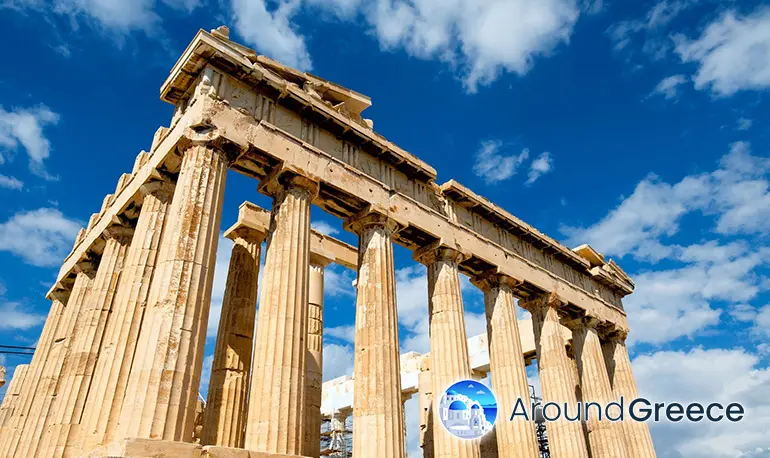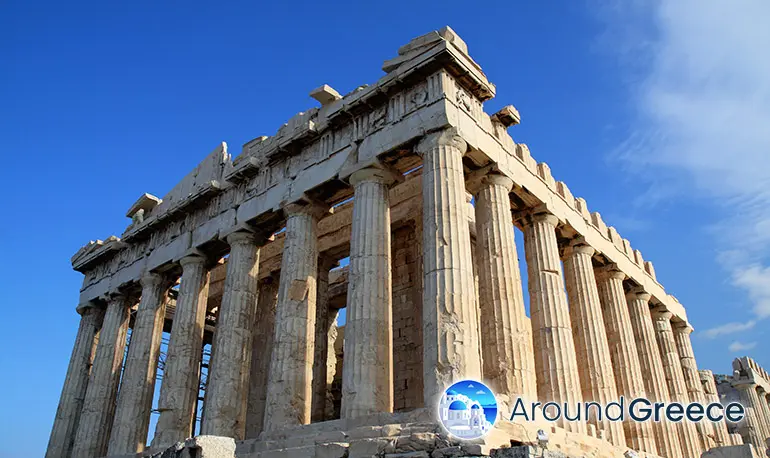The Magnificent Parthenon Temple
During construction, many of the cities greatest sculptors worked on the Parthenon, under the guidance of Pheidias (c.490 – 430 B.C.), who was himself described as the greatest sculptor of all.

The architects of the Parthenon were Iktinos (whose other significant work was the Temple of Hephaestus in the Agora) and Kallikrates (also responsible for the Temple of Nike on the Acropolis). With the Doric order of architecture, the Parthenon was designed in a most impressive and extraordinary way. Though the structure may appear with geometrical symmetry, there are in fact no straight lines.
All of the columns and other seemingly straight lines are actually tilted inwards by 6cm, while the steps incline by 12 cm. This combination creates an optical illusion know as entasis (intensification – this refers to the slight swelling of columns as they rise upwards, in order to counter the optical effect up standing at the base of the temple and looking upwards). Through the use of detailed mathematics and excellent craftsmanship, any appearance of disproportion was corrected.
The completion of the Parthenon is only 9 years in 438 BC resulted in a temple that overshadowed everything else that had ever been built in Greece up to that time.
The Parthenon's Dimensions
The dimensions of the Parthenon, measured from the top step are 30.9 meters (101 ft) in width, by 69.5 meters (228 ft) in length. The cella ( which was the main body of the temple, and also known as the “cult chamber”), was approximately 30 meters (98 ft) in length by 19 meters (62 ft) in width.
The cella of the Parthenon consisted of two rooms, that stretched end to end, with internal rows of Doric columns inside. The famous 12 meter (40 ft) statue of Athena, consisting of a wood and marble base, adjourned with gold and ivory, designed by Phildias resided inside the cella. The statue itself was a piece of extremely beautiful art, which represented Athena, armed with a spear, shield and helmet and accompanied by a serpant. Her right arm was extended holding a statue of victory.

This statue was actually finished before the completion of the temple. The statue remained in the cella, until the 5th Century A.D., where it was removed to Constantinople and subsequently disappeared. Access to the cella was through a 10 meter (33 ft) door which was cut out of the eastern portico (a porch or walkway). The treasury of the Delian League was also located in the Parthenon, and the four Ionic columns that once supported the ceiling can still be seen today.
The Parthenon Frieze
As well as the statue of Athena, the Parthenon was decorated with some of the most beautiful works of art and sculptor, both externally and internally. The cella was lined on three of it's sides with a huge frieze, showing the main annual festival that honoured Athena, the Panathenaia. On the fourth side of the cella, there was a frieze depicting all of the Gods of the Greek Pantheon.
Externally, there were friezes that ran along each side of the Parthenon, above the columns. The eastern side depicted the battle between the Gods and the giants. The west showed the battle of the Greeks and the Amazons. The southern depicted the battle of the Centaurs and the Lapiths. The northern side remains somewhat of a mystery, though many believe that it depicted images from the Trojan War.

On the front and back of the Parthenon, above these lower friezes, were the pediments. The eastern side showed the birth of Athens, whilst the western showed Athena's battle with Poseidon over the control of Attica. These pediments, are the triangle areas you will see, forming the peak of the structure at the front and back.
The creative genius of Phildias can be truly appreciated with regards to the friezes that originally made up the pediments. Using the triangle shape to his advantage, he placed figures in various positions according the the space in the triangle. Some were standing, kneeling, lying down or leaning. He was able to fill this somewhat difficult shape with a piece of work that one can only describe as truly inspirational and unique.
Sadly, there are hardly any remains of these great friezes that proudly decorated the exterior of the Parthenon, that you can see when visiting the site. To see them, you must head down to the Acropolis Museum where you will see many on display, while you will also have to visit the Louvre in Paris, and the British Museum in London to see the others. However, when visiting the Parthenon, it is not difficult to picture in your mind how this monumental structure must have appeared all those years ago.
For more information about the Parthenon Frieze, head over to parthenonfrieze.gr where you can digitally explore the magnificent frieze.
The Parthenon Today
Today, the whiteness of the marble columns of the structure often give the image that in ancient times, the appearance of the Parthenon was the same as you will see it today, not taking into consideration the damage that has been caused to the structure.

This however was not the case. As with many other ancient temples in the city, as well as all around Greece, these mighty structures were often partially painted, though there can be no definitive answer on the exact colours used. It is known that internal ceilings were usually painted a deep blue colour. Some also believe that the upper parts of the Parthenon were painted with bright colours, such as blue and yellow. This would have been done in order to make the sculptures that were placed around the outside and on the pediments stand out much more when looked at from below.
Though the Parthenon is the most impressive and inspiring structure on the complex of the Acropolis, it is by far not the only one of importance. There are many other buildings and structure that were constructed at the same time as the Parthenon, and their importance should not be underestimated.
If you are interested in organized tours of the Acropolis and Parthenon, head over to our Athens tours page, where you'll find a huge selection of exciting tours and excursions.